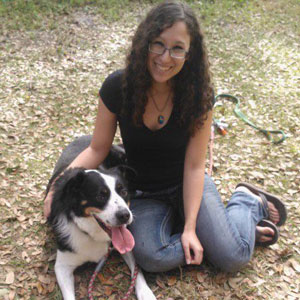Alleviate stress in your dog
How to recognize and alleviate stress in your dog
by Gillian Daniels, CPDT-KA
Gillian is the training manager at Clearwater-based New Dawn Animal Behavior, which uses positive, rewards-based training. Daniels’ goal is to encourage dog owners to consider their dog’s emotional needs and learn how to read their body language. For more information, visit NewDawnABC.com *article first appeared in Feather Sound News, November Edition |
| Like humans, pets can feel stress. They experience a wide range of emotions, including stress and anxiety, and express these emotions through multiple verbal and physical cues. Activities that we think are normal, like going to the vet or riding in the car, may be high-stress situations for your pet. As humans, we’re accustomed to these situations, but your pet may find them stressful. It’s important to recognize when your dog is experiencing a stressful situation. Common signs of stress in dogs include shaking, pinned-back ears and whining, but individual dogs may show it in different ways. Here are some other signs of stress in pets. Excessive drooling or panting. Stressed dogs often produce more saliva than normal. Dogs can also begin to pant continuously, even when they aren’t in a hotter environment or just finished exercising. Lowered or tucked-in tail. When a dog is experiencing fear or anxiety, he will lower his tail or tuck in his tail between his legs to indicates that he is not comfortable with the situation. Pet owners should look for other signs of stress such as excessive panting to confirm their pet is in a high-stress situation. Excessive shedding. Some dogs experience more-than-usual shedding when they are in a stressful situation, like going to the vet. If you notice more of your pet’s hair on the seat or floor than normal, then your dog is probably afraid of its upcoming examination. Yawning. Dogs don’t only yawn when they are tired. Dogs will often yawn as a sign of anxiety when placed in stressful situations. When dogs yawn continuously, it usually means the pet is trying to displace its anxiety and uncomfortable feelings. |
Half-moon eyes. Usually, the whites of a dog’s eyes do not show. But you may see a crescent shape of white, known as the half-moon eye, in stressful situations. Look to see if your dog’s eyelids are raised which shows the whites of his eyes, to see if he is feeling stress or anxiety.
Decreased appetite. Some dogs lose interest in their food and refuse treats when they are stressed. A decrease in appetite might be caused by stress or a health condition, so it’s important to recognize when your pet is in a stressful situation, or if they need to go to the vet to evaluate their health. Now that you know the signs of stress or anxiety in dogs, you may discover that certain situations or places are stressful for your pet. There are actions that you can take to help your pet manage his stress and anxiety. Alleviate the stressful feelings. Removing your dog from the stressor is the best course of action, but sometimes it’s not possible. For example, your dog may feel stressed during veterinary visits, but routine care is best for his or her health. Regular mental and physical exercise, proper diet, consistent routines, and using counter-conditioning and desensitization protocols with the assistance of a certified professional dog trainer can help your pet manage his stress. Create safe zones. Thunderstorms, fireworks and different people in the home can be stressful for pets. Create a safe zone for your pet with a blanket-covered crate or allow the pet access to a dark, private room or closet where he can feel safe. Consider medication. Some medications may be used for situational stresses, while others are used daily. Medication and behavior training can be very effective in helping pets manage their anxiety. If you are interested in discussing anxiety medication for your pet, please contact your veterinarian or our specialists at SPCA Tampa Bay Veterinary Center. Get training assistance. Behavior training classes can also help you recognize stress in your pet and teach your dog how to deal with everyday stressors. New Dawn Animal Behavior Center offers classes for all dog types, and specializes in working with fearful or reactive dogs through individual sessions. Once you know you what triggers your dog’s stress and how it behaves when stressed, you will be better equipped to identify the signs and take quick action to minimize the stressors. |




Comments
Post a Comment